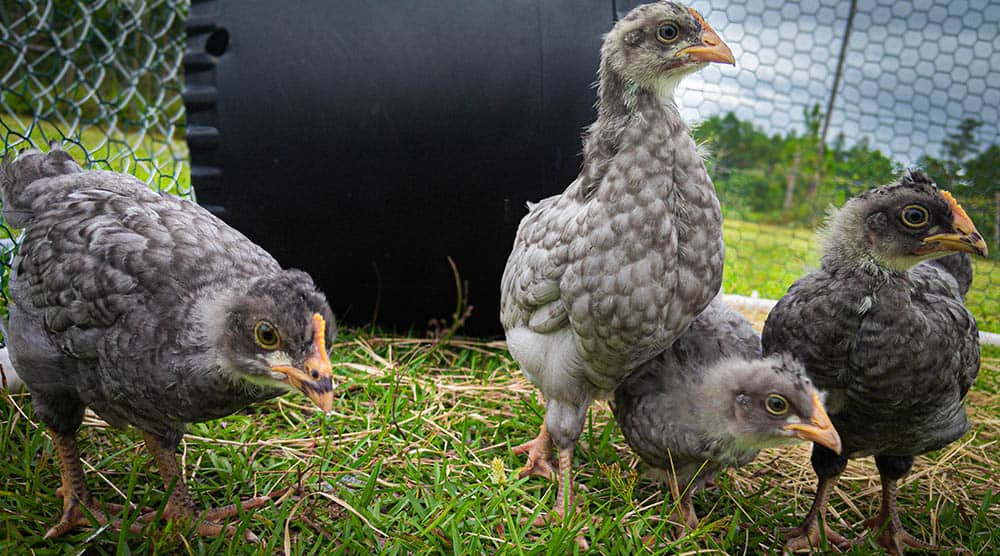When you’re collecting eggs, it’s wonderful to have a wide array of color combos and hues. While gray, white, black, and blue eggs are all commonplace, one color that’s found its way into the egg basket in recent years is the olive-green variety from Oliver Egger Chickens.
But where did Olive Egger Chickens come from, and what can you expect from them? We break it all down for you here.

Quick Facts about Olive Egger Chicken
| Breed Name: | Ameraucanas, Marans, Legbars, and Welsummers |
| Place of Origin: | United States, France, the U.K., and the Netherlands |
| Uses: | Egg production and meat consumption |
| Rooster (Male) Size: | 7 to 8 pounds |
| Hen (Female) Size: | 6 to 7 pounds |
| Color: | Black or gray |
| Lifespan: | 8 years |
| Climate Tolerance: | Very hardy |
| Care Level: | Low |
| Production: | High – 150 to 160 eggs per year |
Olive Egger Chicken Origins
The Oliver Egger Chicken is a new hybrid variety, and it makes up a litany of different breeds. As such, it’s nearly impossible to track down an exact origin.
Common Olive Egger Chickens include Ameraucanas, Marans, Legbars, and Welsummers, and these chickens originate from the United States, France, the U.K., and the Netherlands, respectively.
With such a wide array of chickens that make up the Olive Egger Chicken, it’s no surprise that it’s hard to track down a specific origin.

Olive Egger Chicken Characteristics
An Olive Egger Chicken is a cross between a blue egg layer and a dark brown egg layer. When you cross these two breeds, you get a chicken that lays olive green eggs, which is an Olive Egger Chicken.
But since you can get to an Olive Egger Chicken in so many different ways, it’s hard to characterize them much further than that. They’re a typical chicken in most ways, and they generally lay between 150 and 160 large eggs per year.
Olive Egger Chickens are also a hardy breed that can tolerate any climate in the continental United States, as long as you give them adequate housing. Olive Egger Chickens tend to be friendly, but of course, it all comes down to the parent breeds.
Like most chickens, you can mix and match Olive Egger Chickens with plenty of different chicken types, so there’s no reason not to mix it up in your coop!
Uses
The entire subspecies of chicken has the signature characteristic of producing olive-green eggs, and as such, their primary use is to lay eggs. A good Olive Egger Chicken can lay anywhere from 150 to 160 eggs per year, so it doesn’t take many chickens to get a ton of eggs.
You can also use Olive Egger Chickens for meat production if they don’t turn out to be good egg layers.
Appearance & Varieties
Since Olive Egger Chickens are a hybrid breed and can come from a wide array of combinations, there are tons of different varieties out there. Most Olive Egger Chickens are either gray or black, but you can find brown varieties out there too.
There’s no official definition of what makes an Olive Egger Chicken outside of the egg color, though, so just about any appearance and variety is available.

Population/Distribution/Habitat
While there’s no distinct count on the number of Olive Egger Chickens in the world, considering that there are close to 26 billion chickens out there, there’s certainly no shortage of Olive Egger Chickens.
Almost every chicken available is a domesticated farm chicken, so if you’re trying to track down an Olive Egger Chicken, you’ll need to reach out to a local farm to try to get one.

Are Olive Egger Chickens Good for Small-Scale Farming?
Few animals are as easy as chickens to start caring for and getting a yield from, and Olive Egger Chickens are among the top choices for small-scale farming. Even a dozen chickens can realistically put out 1,800 eggs a year, which is a big yield for such small animals!
If you’re thinking of getting into small-scale farming, there are few better choices than bringing in a few chickens.
See also:
Featured Image Credit: Tabitha Sizemore, Shutterstock
